Menu
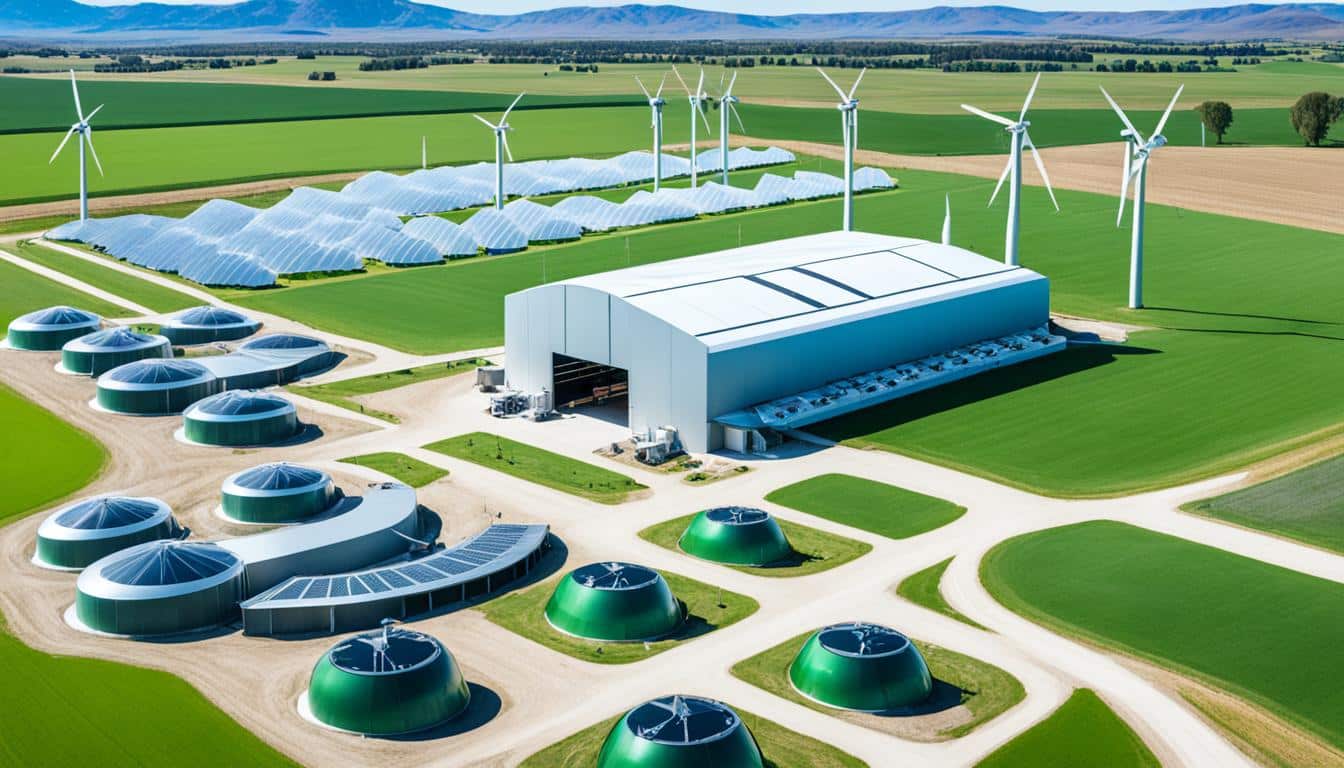
By 2050, the world will need 70% more food. This means we must find new ways to farm that are big enough and good for the planet. Right now, almost 10% of us don’t have enough to eat, making the search for better farm solutions urgent.
The Bee Vectoring Technologies are one such advancement. They boost how well plants are pollinated. They cut down on using harmful chemicals. And, they help by making farming more friendly to the earth.
Another exciting area is precision agriculture. This means using resources carefully and farming in smart, small spaces. Through these methods, farming can be done more sustainably and with less impact on the environment.
High-tech farming for animals is also becoming more widespread. Things like automatic milking and systems that feed animals without antibiotics are becoming common. These changes are not just about making more food. They are also about making sure animals are treated well.
The world’s population is growing fast, pushing us to focus more on food security. The future of livestock farming stands out as key. We must use new methods and technologies to ensure we meet food needs without harming our planet.
Now, about how much meat and dairy we eat. In the last 30 years, people in low and middle-income areas have tripled their intake. The story is the same in the US, with each person eating 222lbs of meat yearly. With this demand expected to jump by 80% in a decade, it’s clear we need to find ways to produce more meat and dairy without damaging the earth.
Livestock depend heavily on cereals for their feed, using a third of the world’s supply. But, they also turn food we can’t eat into steaks and milk. This points out both a problem and a chance for us: how to keep our food system going while being kind to the environment.
We now have over 1.4 billion cattle and billions of pigs and chickens worldwide. This big livestock community needs two billion hectares of land for grazing. But, new farming systems can help us produce more protein without using extra land.
Improving the way we farm is critical. For example, in the USA, dairy cows make four times the milk they did 75 years ago. This leap is thanks to hi-tech methods like sorting cows by their genes and helping them get pregnant in the best way.
Then there’s precision farming, with cool tools like drones and smart wearables. These gadgets give farmers instant feedback, meaning they can manage their animals better. This is super important as we prepare to feed 9 billion people by 2050.
Now, let’s talk about the good food does. A glass of milk tops up your vitamin B12 need by 150%. And a small beef steak gives you plenty of the iron you need as an adult. These examples show why it’s vital to bring new and eco-friendly ways into farming. This way, we can make sure everyone gets the food they need.
So, changing how we do livestock farming, to be both efficient and green, is more than a dream. It’s a must-do. We’re looking forward to making farming better for everyone. This includes more food, safety, and a healthier planet.
Precision livestock farming is a big step in farming, using detailed data to make better decisions. It helps farmers use their resources better and make their farms more productive and profitable.
Data collection is key in this new type of farming. High-tech tools like IoT sensors and GPS track animals’ health and habits all the time. This info lets farmers make quick and smart choices. This kind of farming means less waste and more efficiency.
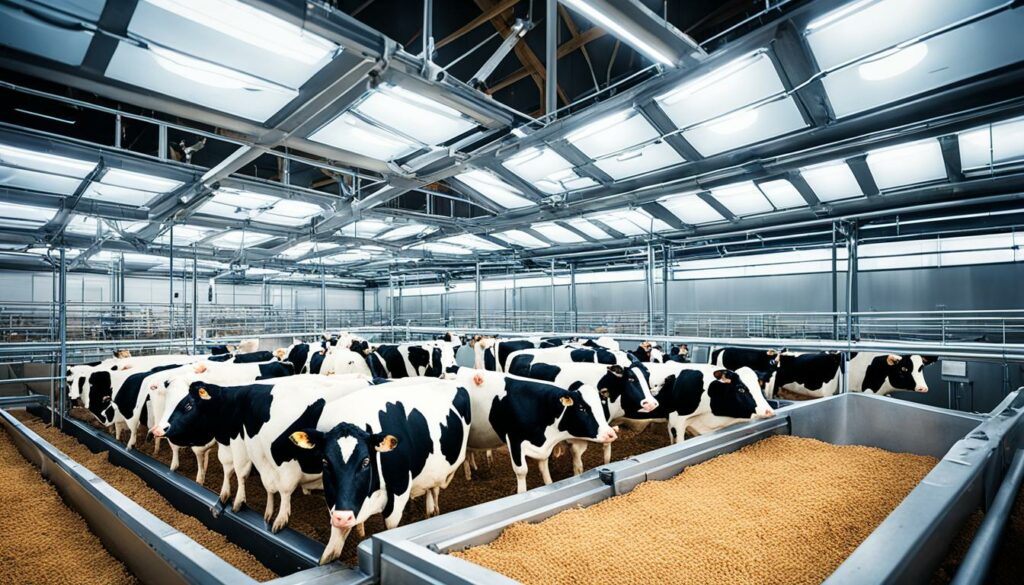
Automation is changing how we farm animals with systems like robotic milkers. These systems are precise and take care of the animals well. They make farming less hard work for people and improve how animals are looked after. Devices that monitor health help spot and treat diseases early.
Big Data and AI are making a big difference in farming. They use smart technology to learn about animals’ health and growth. These tools help farmers make the best decisions, improving the way farms work.
This farming approach is growing fast and could be worth over $16 billion by 2028. The use of AI in farming leads to better and more sustainable ways of farming.
It’s crucial to use farming techniques that don’t harm nature. Regenerative agriculture helps keep ecosystems healthy. This includes practices like letting animals graze freely and moving them to new spots regularly.
In pasture-based farming, animals roam freely. This lets them act naturally and makes them happier. It also feeds around 1.3 billion people. Around 500 million people living in pastures depend on this for their jobs.
However, this way of farming also creates a lot of harmful gases. Shifting to better practices, like letting animals graze freely, can reduce these gases. This is good for the environment.
Rotational grazing moves animals to new land regularly. This prevents the land from getting damaged. It helps grass grow back and soil to stay healthy. Allan Savory has shown this can even fight climate change. Better land use can lower greenhouse gases, making farming more eco-friendly.
Efforts in places like Kazakhstan show a worldwide move towards better farming. The World Bank is also helping in Ethiopia and Bangladesh. They aim to support farming that’s good for the planet.
Animal welfare technology is changing the way we look after farm animals. It makes livestock management more humane and ethical. This tech not only improves animal care but also boosts the efficiency and work on farms. Over the last ten years, there have been big steps forward. Many new ideas are now used by farmers, especially those working with dairy cows. In the U.S., there are around nine million dairy cows. The livestock management market is valued at over $30 billion every year, showing its importance.
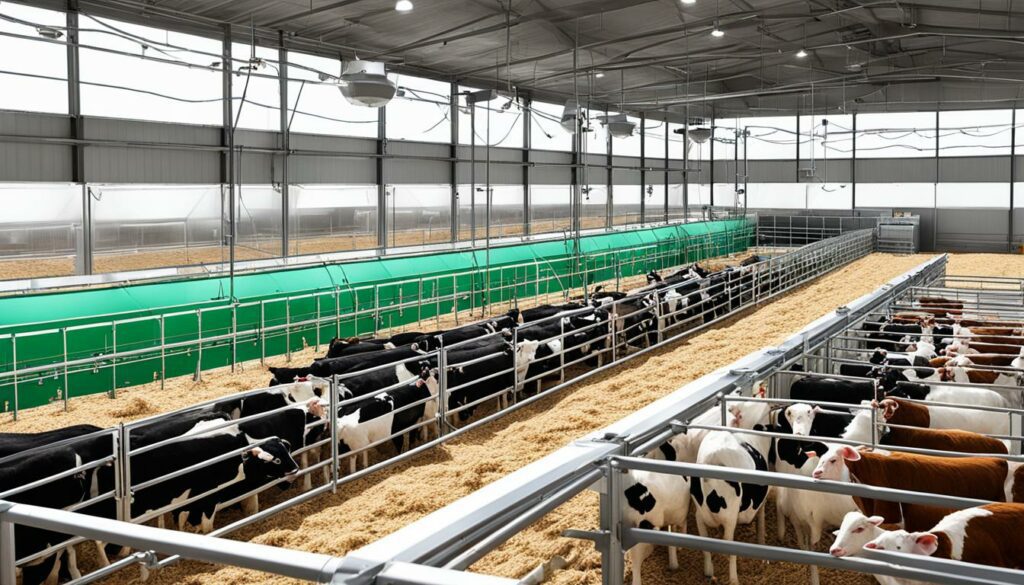
Automated milking systems are key for better animal care. These systems make milking less stressful and more regular. This helps keep the animals healthier and produce better milk. Today, about 12% of dairy farms use robotics for milking. This number is expected to go up to 20% in five years. Companies like Cainthus are at the front, creating new farming tech. They’re making it simpler and more effective for farmers to handle their animals.
Farming is moving towards using fewer antibiotics. Instead, it relies more on treatments that don’t include antibiotics. A good example is using sound waves to treat a disease called bovine mastitis in cows. This is a kinder way to help the animals without using as many antibiotics. It fits with the idea of looking after the livestock in a more caring way.
Tools to watch over the farm’s environment are critical. They use sensors and data to keep an eye on the air, the ground, and the animals themselves. This helps farmers spot problems early and make smart choices to care for the animals. The idea of a ‘connected cow’ uses sensors to keep track of each animal’s health and work. This leads to fewer deaths among the cattle, and less need for medicine, resulting in healthier animals.
Although new farming tech can be hard to start because it’s a big cost, it brings many benefits in the long run. It makes the farm more productive and keeps the animals better. People who invest in farm tech are seeing its value. That’s why the interest in this technology is growing, and so is the market.
In summary, farm technology, including automated systems and treatments without antibiotics, is a big leap towards kinder farming. This new tech aims to make the future of farming more sustainable and caring for the animals.
| Technology | Benefits | Current Adoption | Future Adoption |
|---|---|---|---|
| Automated Milking Systems | Consistent milking, enhanced animal health | 12% | 20% by the next five years |
| Non-Antibiotic Treatments | Humane health management, reduced medication | Increasing | Future growth expected |
| Environmental Monitoring Tools | Optimal conditions, improved productivity | Integrated in modern farms | Wider adoption anticipated |
Smart farming is changing how we manage livestock, using high-tech equipment like sensors and the Internet of Things (IoT). These tools help farmers gather real-time data on their animals, the environment, and how they use resources. This leads to big improvements in how farms run, helping both the economy and society. Let’s explore how these technologies are impacting farming, especially in feeding and managing nutrients.
The use of sensors and IoT in agriculture is a big leap forward. It lets farmers keep a constant eye on their animals’ health and well-being. For example, sensors pick up vital signs and changes in how animals act. This helps farmers make quick decisions to keep their animals safe and healthy.
Technologies like virtual fences and robot milking also help animals while saving on labour costs. Plus, by tracking food from farm to table, IoT improves food safety. Data from IoT devices is analysed through artificial intelligence and machine learning. This smarter analysis means farmers can make decisions down to the individual animal, helping in the best use of resources.
Feeding animals with precision is at the heart of smart farming. By using data from sensors and IoT, farmers create personalised food plans. This helps each animal get exactly what it needs, cutting waste and boosting their health and how productive they are.
Looking deeper at the feed’s ingredients also brings benefits. Drones take images that help understand the state of crops better. These high-tech tools lead to more efficient farming that uses resources wisely, promoting sustainability.
With the world’s population growing, smart farming is essential for the future. This tech is not just for large farms; it also helps smaller ones and those focusing on eco-friendly or special breed animals. By using precision tools, big data, and robotics, agriculture is going through a big change. This new way of farming is about doing more with less in a sustainable way.
| Technologies Used | Benefits |
|---|---|
| IoT Devices and Sensors | Enhanced animal health monitoring and food traceability |
| Robotic Milking Systems | Reduced labour costs and improved animal welfare |
| Precision Feeding Systems | Optimal nutrient delivery and reduced feed waste |
| Data Analysis and Machine Learning | Refined feed composition and improved farm productivity |
Livestock farming makes a big impact on our environment. It’s key in efforts to reduce our carbon footprint and come up with new ways to handle waste. It’s vital for livestock farms to be ‘climate-smart’ and use green methods. This helps lessen the harm to our planet.
Livestock farming is responsible for 18% of the world’s greenhouse gases. This amounts to 7,516 million tons of carbon dioxide every year. Waste from livestock, especially methane, does a lot of harm. In fact, methane is 23 times worse for the planet than carbon dioxide. But, by using certain farming techniques, we can store more carbon in the soil. This helps to shrink the carbon footprint of livestock farming.
In Colombia, adding trees to pastures increased milk production by 17%. It also cut production costs by 18.5%. Moreover, it helped the soil trap more carbon.
Livestock farms in the U.S. alone produce vast amounts of waste. In just one second, it’s as much as a city with 411,000 people. Managing this waste in smart ways becomes a key task. Turning this waste into things like energy and fertiliser is a big win for the environment. It changes harmful waste into useful resources.
| Environmental Factor | Impact Metrics |
|---|---|
| Greenhouse Gas Emissions | 18% of global emissions |
| Carbon Dioxide Release | 7,516 million tons annually |
| Methane Emissions | 35-40% of total emissions |
| Waste Generation | 116,000 pounds per second in U.S. |
Next-generation farming practices will change how we see farming. They use the latest technology. This has made the domestic livestock market in the United States grow to over $30 billion each year. These new ways of farming include using robots on dairy farms and precision agriculture. By 2025, this precision agriculture is expected to be worth $43.4 billion.
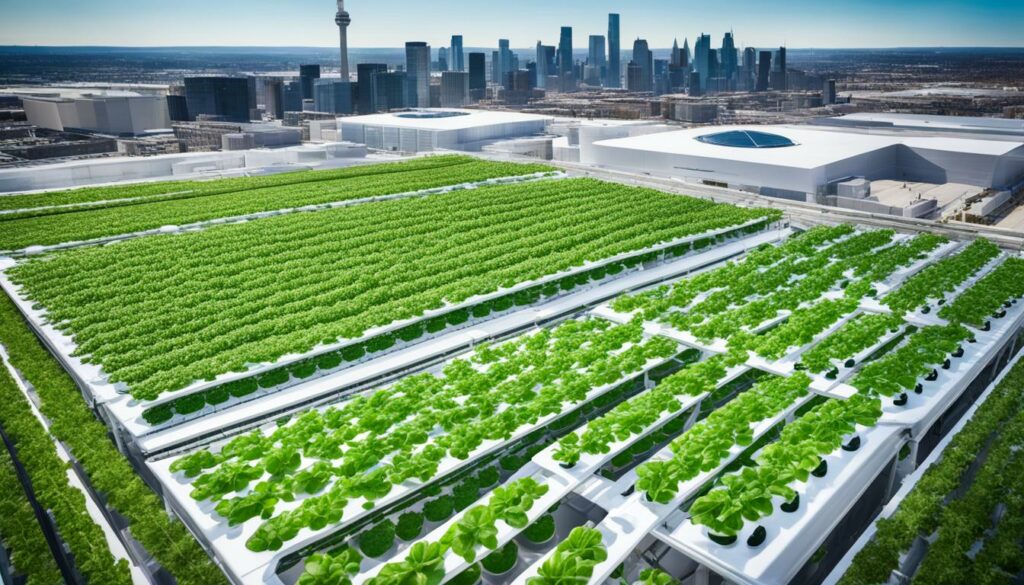
Connected cows show us one example of high-tech farming. Sensors watch everything about a cow’s health. They give us important data. This data helps make cows healthier and more productive. Companies are putting all this technology in one place. This makes it easier for farmers to make decisions. This new way of farming cares a lot about what’s best for the cows. Tyler Bramble, from Cainthus, says it lets animals act more naturally.
Vertical farms are a big step forward in farming. They use much less water than usual. This is great news for our planet. Using blockchain technology, farms can keep better track of their food. This helps with problems like fake food and dangerous products. The farming industry is starting to use these new technologies. It’s slow, but it’s happening. These changes are working towards a future where farming is better for the Earth and for making food.
Farmers in places like Ecofarms in Brazil are doing their part. They work to make their livestock farming not harm the environment. For example, Fazenda Triqueda in Brazil uses a special method to cut down on the bad gases cows make. These new methods help farming be good for the planet and for the economy.
As we look ahead, it’s important to accept new farming methods. These new ways of farming make things better. They help us produce more food. At the same time, they look after the environment and the animals. This is a win for everyone.
| Statistics | Data Insights |
|---|---|
| Annual domestic livestock market value in the US | $30 billion |
| Robotic usage in dairy farms (current) | 12% |
| Predicted robotic usage in dairy farms (next 5 years) | 20% |
| Vertical farm water usage compared to traditional farms | 70% less |
| Precision agriculture market prediction (2025) | $43.4 billion |
Using digital tools in farming is changing how we run farms. It’s making them more efficient and precise. Thanks to the latest software and monitoring gadgets, farmers have much better information. They can make their processes smoother and more effective.
FarmERP is software that gives farmers control over their whole operation. It handles buying, supply lines, and money matters all from one place. This is great for livestock managers. It helps them do their jobs better and make smarter choices. So, farmers can concentrate on taking good care of their animals.
Real-time monitoring is key in today’s livestock farming. It uses tech like milk sensors and virtual fences to give farmers instant info. This helps make wise decisions. By keeping a close eye on what’s happening, farms can run smoothly every day.
In the U.S., for example, there are more than nine million milk cows. So, these high-tech systems are really important. They keep the cows healthy and productive.
Even though the start-up costs are high, the pay-offs over time are worth it. Companies are using the latest in machine vision and data to help farmers. They can spot and prevent diseases in livestock. They make managing farms easier and better. In the future, more and more farmers will use these tools. This will grow the industry even more, beyond its $30 billion value today.
“Digital applications not only broaden the scope of data collection but also enhance the ability to make data-driven decisions,” stated industry experts. “Adopting these tools is crucial for the future of livestock management.”
Livestock farming has changed a lot thanks to new feeding technologies. The need for better and more sustainable practices is growing fast. By 2030, the world will need 80% more meat. This means we must use our land wisely and keep the planet’s health in mind while meeting this demand.
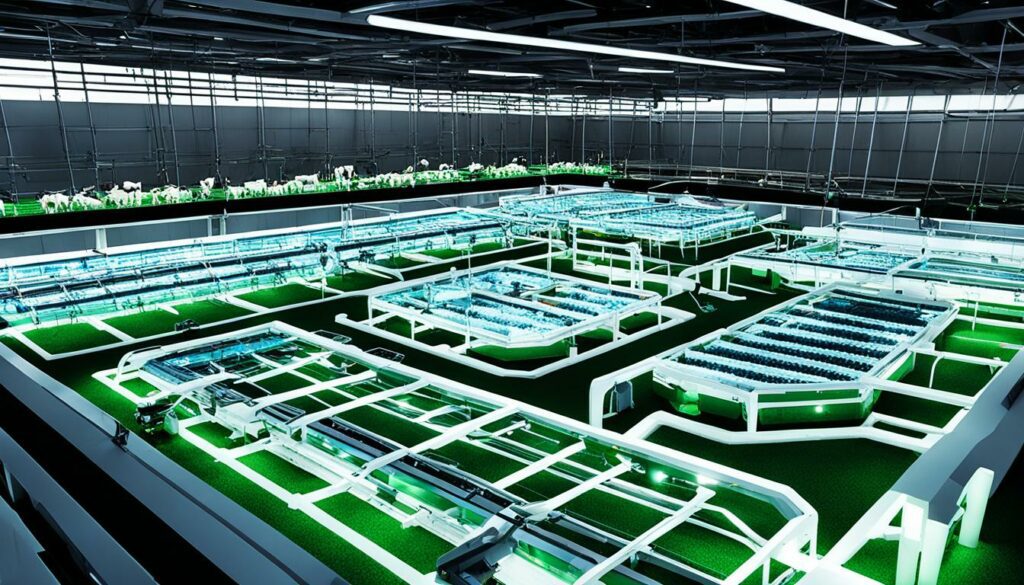
Automatic feeders have made a huge difference for farmers. They give the right amount of food to each animal. This ensures animals grow well and work productively. These systems have cut down on waste and made feeding easier. Because animals eat up a lot of land to make not much food, this efficiency is crucial. Automated feeders help us produce food without harming the environment.
Precision animal nutrition is all about giving animals exactly what they need to be healthy and work well. With new tech, we can adjust their diets whenever needed. Sensors can even check on things like milk quality and whether an animal is pregnant. This means we can feed our animals just right, every day.
Americans eat a lot of meat each year – around 222 lbs per person. People in other countries are eating more now, too. This shows how important these new feeding methods are. Drones and sensors help farmers know exactly what their animals need. This makes the animals grow better and ensures they are well taken care of.
The world of farming is changing quickly. New techniques in handling animals are solving modern problems. There were about 1 billion cows and 767 million pigs in 2019. Chickens reached nearly 1 billion in 2018. These high numbers show a big chance for farming improvements.
Controlled traffic farming is becoming more popular. Farmers like Robert Salmon in the UK are taking the lead. This method keeps heavy machinery to set paths in the fields. It stops the soil from getting too compact, helping crops grow better. Protecting the health of the soil this way is key for keeping farms productive and eco-friendly.
Minichromosome technology is a big step forward in farming. It changes plants to be better at surviving droughts and fighting off pests. This means the crops animals eat are more nutritious and can resist diseases naturally.
People around the world are using these new farming ideas. In 2019, Chew’s Agriculture in Singapore linked up with the Certified Humane programme. In Brazil, Ecofarms is part of a group that supports farming without adding to greenhouse gases. In Kenya, Enonkishu Conservancy is a great example. It looks after livestock, protects wildlife, and helps the Maasai people make a living.
| Technique | Benefits | Examples |
|---|---|---|
| Controlled Traffic Farming | Minimises soil compaction, preserves soil structure | Robert Salmon’s UK-based practices |
| Minichromosome Technology | Enhances genetic traits without altering natural development | Chew’s Agriculture, Ecofarms |
| Holistic Management | Balances livestock production and conservation | Enonkishu Conservancy |
Livestock farming is set for big changes. New trends and solutions are tackling farming issues. The need for meat and dairy will go up by 80% by 2030. This makes sustainable farming vital.
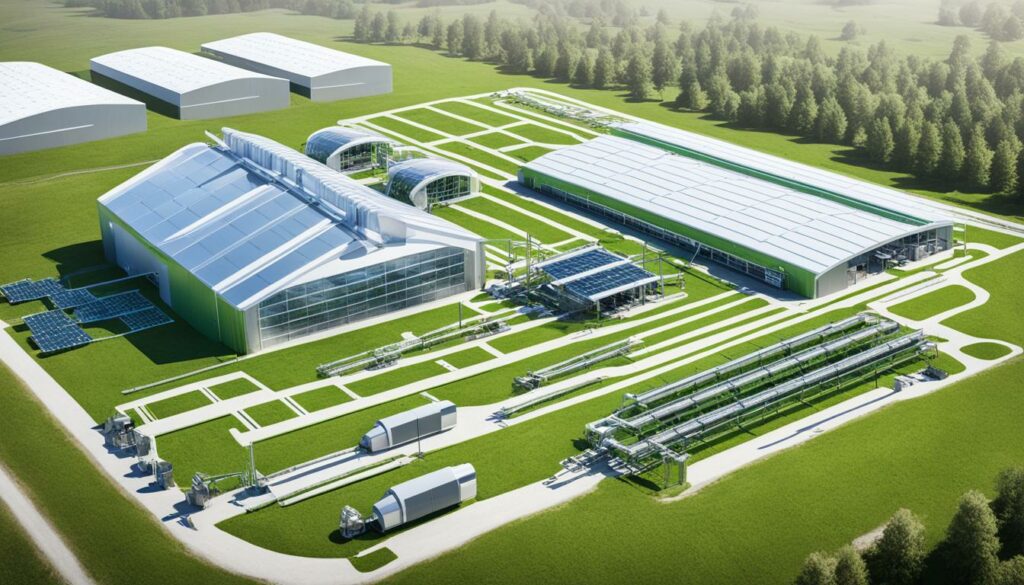
Over the last thirty years, more people in poorer countries are eating meat and dairy. This shows we must make farming more efficient. In the USA, a dairy cow today makes four times more milk than in the past. This proves how farming better can boost what we get from animals.
Technology is key for the future of farming. Robots are helping with tasks like milking and feeding. They make processes quicker and easier on the animals. Cellular agriculture is also exciting. It could help us make more food without harming our planet more.
The future faces problems like weather changes and too much greenhouse gas. These gases are 15% of the world’s total. We need to do many things to fix this, including using special feed additives.
Making the most of our resources is also a challenge. At the moment, around 40% of farmland goes towards livestock, but they only provide 20% of our food’s energy. Using systems like silvopastoral farming can help. It can up produce by 64%.
| Challenge | Solution | Outcome |
|---|---|---|
| Increased Emissions | Feed additives like 3NOP | 30% reduction in methane emissions |
| Resource Efficiency | Silvopastoral systems | 64% increase in protein yield |
| Manure Management | Bluetector’s treatment systems | ROI in one to two years |
Improvements in digital farming and waste handling are also key, worth $3.9 trillion. Innovations like those from Bluetector are affordable and pay off fast. This shows we can make farming better and more profitable.
Adapting and innovating are crucial for the livestock industry’s future. By using new trends and tackling challenges head-on, we can create a thriving and sustainable industry.
Artificial intelligence (AI) is altering the way we farm animals. It brings in high-tech tools to boost how efficiently we farm, keeping our practices sustainable. AI’s role in farming covers areas like tracking animal health, making the most of milk outputs, and handling breeding processes.
In agriculture, machine learning is changing the game by offering smart, data-driven answers. The University of Florida, for example, is using AI in dairy settings. They watch over cows’ health, milk production, and how well they reproduce. These tactics help in spotting diseases early and making treatments tailored.
Platforms such as MilkingCloud are key in up-to-the-minute animal health checks. This means quicker actions when diseases are found. MilkingCloud also tracks what animals eat to create feeding plans that boost health and milk but cut costs.
AI decision support systems are shaking up farming. They use signals to make farms more efficient and better with their animals and crops. For instance, they help in choosing the best cows for breeding. MilkingCloud’s data help farms cut their environmental impact, pushing for eco-friendly farming.
These technologies reach into tasks like robotic milking and smarter decision-making. They make milking more efficient and improve milk quality. Decision support systems ensure each animal gets the right food and feels less stressed. This blends better farming practices with top-tier technology for happier, more productive cows.
Today, robots are changing the way we farm animals. This is not just about being more efficient. It’s also about caring for animals better. With the need for meat and dairy going up, we have to use these new technologies. They help keep the places the animals live clean and healthy.
These new systems make sure animals are fed and milked accurately. They are part of a bigger shift to more modern farming. This is good for both farmers and the animals they take care of.
Automated systems are key to keeping farm animals healthy. By using these systems, we decrease disease spread. This means a safer and more eco-friendly farm. Over two billion hectares are needed for livestock, so using technology is vital for managing farms well.
Also, this reduces the need for hard manual work. It lets farm workers do other important jobs. Companies like Cainthus watch animals using cameras and sensors. This makes sure the farm is always a clean and safe place for animals.
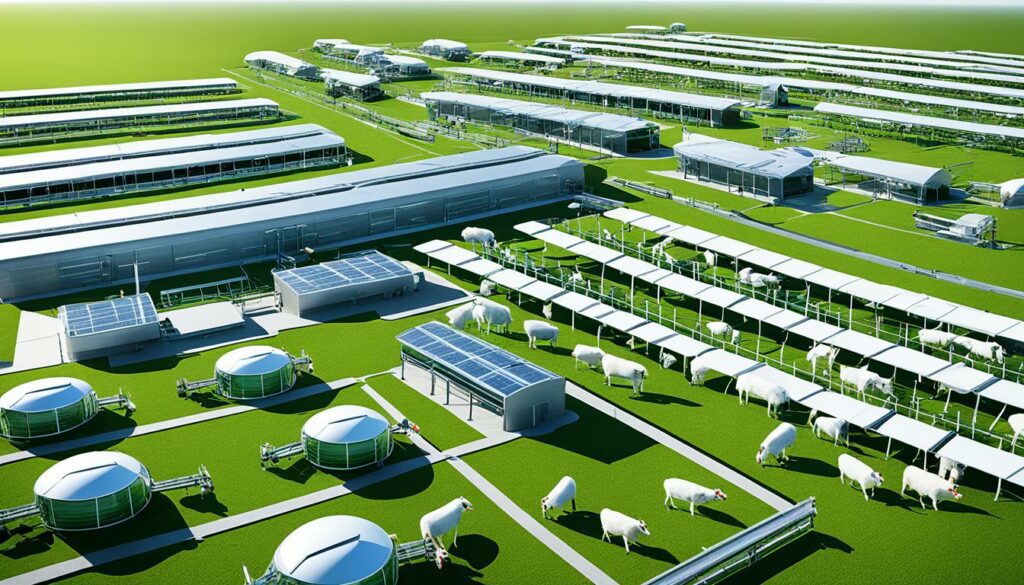
Technologies are changing how dairy farming works. Today, cows in the USA produce four times more milk than they used to. This is partly thanks to new automated systems. These technologies allow for perfect feeding and milking, increasing how much milk we get and its quality.
About 12% of dairy farms use robots now. But this number could go up to 20% in the next few years.
Below is a table that shows how automated systems compare to old ways:
| Aspect | Automated Systems | Traditional Methods |
|---|---|---|
| Labour Requirement | Low | High |
| Productivity | High | Moderate |
| Consistency | High Precision | Variable |
| Animal Welfare | Improved | Standard |
| Environmental Impact | Reduced | High |
Using robots in farming helps us be more productive. It also cares for the environment and the animals we farm. As we go forward, these automated systems are more important. They help us keep up with needing more food in a good way. This ensures that farming continues to be efficient and kind to animals.
Managing water well on livestock farms is key to a steady supply and reducing waste. Agriculture uses 70% of the world’s fresh water. So, finding new ways to save water on farms is very important. It’s been predicted that the world’s thirst for water will go up by half from 1995 to 2025. This means we need to get good at using water efficiently through smart water management.
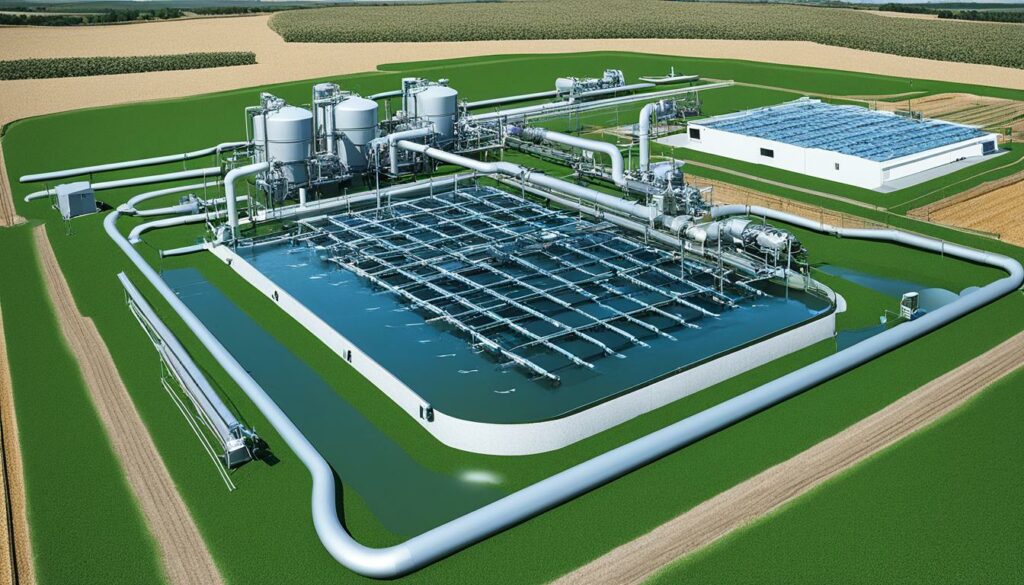
Livestock farming is a major user of fresh water, needing 92% of what we use. We need to create water systems that fit the needs of animals while also caring for the environment. The water footprint of beef is particularly big, using up to 15,500 litres for each kilo. This highlights the importance of being smart about our water use.
Dealing with these big tasks means looking into efficient irrigation systems. These systems can make better use of water for crops. We also need to think about where farms are. Some places, like Belgium and the United Kingdom, don’t get much rain. They deal with a lot of water stress. New ways of managing water can help these places cope with climate change.
It’s not just about using water on farms. Making feed takes up over 98% of the water used in meat production. Better irrigation can save a lot of water here too. Using smart water management in farming can keep the balance between growing food and saving water. This supports a future where farming can thrive without harming the environment.
| Region | Water Usage (Litres per Kg) | Water Stress |
|---|---|---|
| Beef Production | 15,500 | High |
| Dairy Production | 1,000 | Moderate |
| Pork Production | 6,000 | Medium |
| Poultry Production | 3,500 | Low |
Biotechnology boosts farming by making animals healthier and more productive. It tweaks genes to make livestock the best they can be. This means they grow faster or have better quality products. When animals can fight off diseases better, we don’t need to use as many antibiotics. This helps keep our farms eco-friendly for the future.
Now, thanks to biotechnology, animals keep getting better. Dairy cows are producing more milk. Beef cattle are even tastier. In 2012, the USA was heavily using biotechnology in its crops. It’s proof that focusing on genetic improvements boosts productivity in farming.
One big win of biotechnology is animals that are better at fighting diseases. Genetically altered cotton, for example, keeps bugs away without lots of pesticides. These changes help the animals stay healthier. They also save the planet by cutting down harmful chemical sprays. Tools like CRISPR/Cas9 are fine-tuning animal genes to make them disease-fighting champs.
In 2012, the global biotech crops’ area was big news. It came from the International Service for the Acquisition of Agri-biotech Applications. This showed how much farmers around the world were welcoming biotechnology. Their efforts are leading us to a future where farming is both high-yielding and eco-conscious.
The way we farm animals is changing, aiming for methods that are kinder to nature, more efficient, and better for animals. In China, for example, livestock is becoming more important economically. It went from making up 18% of total farming value in 1980 to 37% in 2006. So, livestock plays a big part in farmers’ incomes, being 40% of what they earn.
There are a lot of animals in China, with 106 million cattle, 465 million pigs, 300 million sheep and goats, and 14.2 billion chickens, ducks, and geese in 2003. But, this big number of animals causes environmental problems. For instance, in 2008, these animals produced 1.73 billion tons of manure from farms that’s a lot! It was more than the solid waste from industries. However, despite these issues, China’s ability to produce animal feed has grown a lot. In 2008 alone, they made 137 million tons of feed, which was worth $64.5 billion.
We must look at how farming animals impacts the environment. The FAO thinks the world’s need for animal products will double by 2050. This growth will need to be done in an eco-friendlier way. We are also talking about eating less meat in richer countries to help the planet. Still, with more people wanting meat, especially in poorer countries, and about 800 million without enough animal food, this is a big challenge that we must tackle.
Farming animals also adds a lot to greenhouse gases, making up 14.5% of them all. Beef and cattle milk are the main culprits, with beef production causing more greenhouse gas than making tofu. Also, feeding animals is often wasteful, with only 12% of the food they eat turning into food for us. Finding better ways to farm is critical. We need to support models that are kind to the planet and still productive.
Farming is advancing using precise techniques, green practices, and smart tools. This helps boost work, save our planet, and look after animals better.
It brings together data, machines, and smart tech to make farms work better. By shrinking waste, it helps farms be sharper, cleaner, and make more profit.
Farms are now choosing grazing methods that keep the land healthy. This stops the land from being worn out and helps both the earth and the animals stay well.
Thanks to tech like automated milking and natural treatments, farms are kinder and more efficient. This means animals are happier, healthier, and work better for us.
They use high-tech sensors and the Internet of Things (IoT) for up-to-the-minute farm info. This data helps make sure animals get exactly what they need, improving farm efficiency.
Livestock can cause pollution and waste. To tackle this, new methods cut down harm, keep the land healthy, and turn waste into useful stuff like clean energy and fertiliser.
New farming uses the latest AI, robots, and DNA science to make farms work better, stay clean, and keep animals happy. These methods aim for top-notch performance, green living, and animal care.
The sector offers software and systems, like FarmERP, to run things smoothly. They collect farm facts in one place, making it easier to decide and do things better.
New feeding tech, like automatic systems and careful meal plans, means animals get the perfect food. This leads to a balanced diet, great health, and top performance.
There are cool farming techniques, like special traffic and tiny DNA bits. They make farms less messy, boost genes, and help plants survive without much water.
Exciting new tech, like AI and new biology, is coming. But, reaching farms and dealing with changing weather and morals will need smart education and support from rules.
AI makes smart tech that learns and helps farms work better. It predicts animal health, plans on using resources, and picks the right parents for baby animals, making farms more productive and greener.
Robots help with farm chores, like cleaning, milking, and feeding animals. They make things more exact, do the same job all the time, and cut down on hard work, helping both farms and animals.
Important is using water well and taking care of the land. New ideas make sure enough water is there for both farms and nature, for a lasting and caring use.
Biotech brings new genes to make animals and farms stronger and healthier. It aims for the best animal traits, fights microbes, and cuts back on medicine.